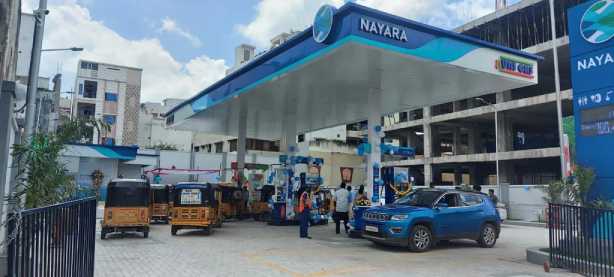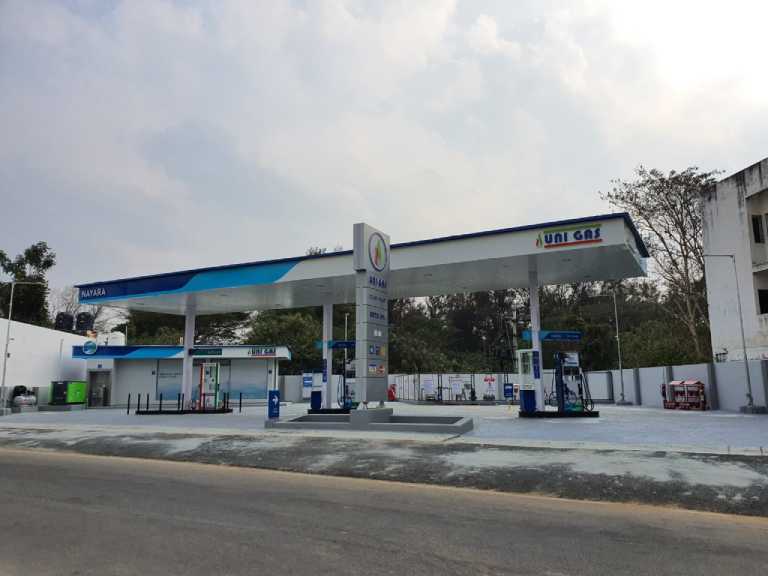.png)
.png)
Samriddhi Energies is one India’s leading companies in AutoLPG. We have collaborated with the prestigious Nayara Energy to provide MS/HSD facilities through our outlets. This collaboration enables us to expand our offerings to include MS/HSD dispensing facilities along with Lubricants thus providing a one-stop-shop for all fuel requirements. This collaboration has become extremely advantageous to all our partners.
Furthermore, we intend to diversify our services to offer alternate fuel sources such as EV Charging, Battery Swapping etc.
Auto LPG is a gas at normal temperatures and atmospheric pressure but can be liquefied with moderate pressure or temperature reduction. This unique property makes Auto LPG an ideal energy source for the mobility sector, as it can be easily condensed, packaged, stored, and transported. When the pressure is released, the liquid expands to 250 times its volume, allowing for large amounts of energy to be stored and transported compactly.

Auto LPG is a popular fuel option in India due to its clean, high octane, abundant, and eco-friendly nature. It is primarily derived from natural gas through fractionation and crude oil through refining and is a mixture of petroleum gasses such as propane and butane. The higher energy content in Auto LPG results in a 10% reduction in CO2 emissions when compared to MS, making it an environmentally friendly choice.
The use of Auto LPG has gained popularity in recent years due to its eco-friendliness and affordability. Auto LPG’s greenhouse emissions are less than any other fossil fuel when measured through the total fuel cycle. The conversion of petrol vehicles to Auto LPG substantially reduces air pollution caused by vehicular emissions. In fact, the financial savings on account of conversion to Auto LPG in comparison to petrol is about 35-40%, making it a cost-effective option for consumers. Additionally, low filling times make it a convenient choice for consumers, leading to a growing demand for Auto LPG vehicles in India.

To serve the Heavy-Duty Transportation sector in India, Samriddhi
Energies is currently setting up Auto LNG stations across India.
Auto LNG is cheaper than diesel, the primary fuel used in heavy-duty vehicles in India. This makes it an attractive option for long-distance haulage, leading to significant cost savings for fleet owners and transporters.
Auto LNG produces significantly less carbon dioxide, nitrogen oxides, and particulate matter than diesel. This is crucial in India, where air pollution is a significant public health concern.
India is heavily reliant on imported crude oil to meet its energy needs. By promoting the use of Auto LNG, India can diversify its energy mix, reduce its dependence on crude oil imports, and improve its energy security.
Auto LNG has a higher-octane rating than diesel, resulting in better engine performance, including higher power output and better fuel efficiency.
The Indian government is actively promoting the use of Auto LNG to reduce emissions and improve energy security. They have provided various incentives, including tax exemptions and subsidies, to encourage the adoption of Auto LNG by fleet owners and transporters.
India has significant reserves of natural gas that can be used to produce LNG. The use of domestic resources for energy production can reduce India’s import dependence and create job opportunities in the domestic energy sector.
Auto LNG engines are quieter than diesel engines, which is particularly important in densely populated urban areas. Reduced engine noise can help reduce noise pollution and improve the quality of life for nearby residents.
Auto LNG is a cleaner-burning fuel that emits less greenhouse gases than diesel. By promoting the use of Auto LNG, India can reduce its dependence on fossil fuels and move towards a more sustainable and environmentally friendly energy system.
Auto LNG engines are more fuel-efficient than diesel engines, which can result in lower fuel consumption and operating costs for fleet owners and transporters. This improved energy efficiency can also help reduce carbon emissions and improve environmental sustainability.
The increased use of Auto LNG in heavy-duty vehicles can create new economic opportunities, including jobs in the domestic natural gas industry and increased trade opportunities for LNG exports. This can contribute to economic growth and development in India.
Samriddhi Energies supplies Ethanol to all the OMCs to help them
reduce their Energy Costs.
Ethanol is a renewable energy source that can be produced from various feedstocks. In India, sugarcane is the primary feedstock used for ethanol production. Using ethanol as a fuel helps reduce dependence on fossil fuels and creates new opportunities for the domestic agriculture sector.
Ethanol is a cleaner-burning fuel than gasoline, emitting fewer greenhouse gases such as carbon dioxide and nitrogen oxides. By using ethanol, India can reduce its carbon footprint and improve air quality.
India is heavily dependent on imported crude oil to meet its energy needs. By promoting the use of ethanol, India can diversify its energy mix, reduce its dependence on crude oil imports, and improve its energy security.
Ethanol is cheaper than gasoline, making it an attractive fuel option for Indian consumers. It is also cheaper to produce ethanol domestically than to import crude oil.
Ethanol can be blended with gasoline to produce fuel with higher octane ratings, resulting in better engine performance and fuel efficiency. The Indian government has mandated the blending of ethanol with gasoline, providing further incentives for the production and use of ethanol.
Ethanol production can also have positive environmental impacts, such as reduced soil erosion, improved water quality, and reduced waste generation.
Ethanol has lower toxicity compared to gasoline, which can have harmful effects on human health. By using ethanol, India can improve public health and reduce the negative impacts of air pollution.
India has limited crude oil reserves and relies heavily on imports to meet its energy needs. Ethanol offers an opportunity for India to become energy-independent and reduce its dependence on foreign sources of energy.
The production of ethanol can create new job opportunities in rural areas where feedstocks are grown, providing economic development and improving the standard of living for rural communities.
Ethanol production from sugarcane in India has been found to be carbon neutral, meaning it does not contribute to greenhouse gas emissions when produced sustainably.
Ethanol has a lower volatility than gasoline, making it less likely to ignite or explode. It also has a lower flash point than gasoline, which means that it is safer to handle and transport. Ethanol is also biodegradable, meaning that it breaks down naturally in the environment and does not contribute to soil or water pollution.
Ethanol production can be sustainable if it is produced using renewable feedstocks and sustainable production practices. This can help to preserve natural resources and protect the environment.
